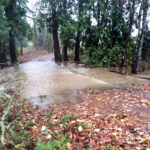Update: Construction has begun! Stay tuned for project updates in this post.
When the East Multnomah Soil and Water Conservation District purchased Headwaters Farm in Gresham five years ago, we saw it as an opportunity to do what we do best: promote clean water, healthy soil, and wildlife habitat. We quickly found a project on the property that addresses all three at once: replacing the culverts for safe fish passage.
The North Fork of Johnson Creek flows through three culverts on Headwaters Farm that are either old, undersized, or perched (a perched culvert is one where the outlet is higher than the downstream water surface). All three act as barriers to salmon as they swim upstream to lay their eggs.
- Sediment runs off the farm and into the stream. Since this photo was taken, improvements have been made to reduce runoff.
- Heavy rains and undersized culverts caused the North Fork of Johnson Creek to flood in December 2015.
Undersized culverts can also cause flooding, which is what happened at Headwaters Farm last winter. Everyone knows that floods can be devastating for our roads and homes, but they also wash nutrient rich topsoil off fields and into streams. When this happens it degrades the health of the soil and the health of the stream at the same time.
Each of the crossings will be improved using different techniques. One culvert will be enlarged for greater capacity, one replaced with a bridge, and one will be removed entirely by eliminating the road crossing. When construction is finished, all three will allow fish to pass through freely.
But wait, are there even salmon in that part of Johnson Creek?
Not yet, but that’s about to change. The culvert projects at Headwaters Farm this summer kick off a huge coordinated restoration effort with our partners at Johnson Creek Watershed Council, Multnomah County, Portland Parks & Recreation, and Oregon Department of Transportation. Over the next two years we will work together to remove an additional four culverts that are still blocking fish passage downstream of Headwaters Farm, opening up the entire North Fork of Johnson Creek to salmon.
“We’re really happy to see so many organizations coming together to add nearly two miles of salmon habitat to the Johnson Creek watershed”, says Julie DiLeone, our Rural Lands Program Supervisor, “it’s going to be great for the folks who live here to see salmon return to the area.” Once all seven barriers are removed, we could see Coho salmon heading up the North Fork almost immediately, and Headwaters Farm will be ready for them.



